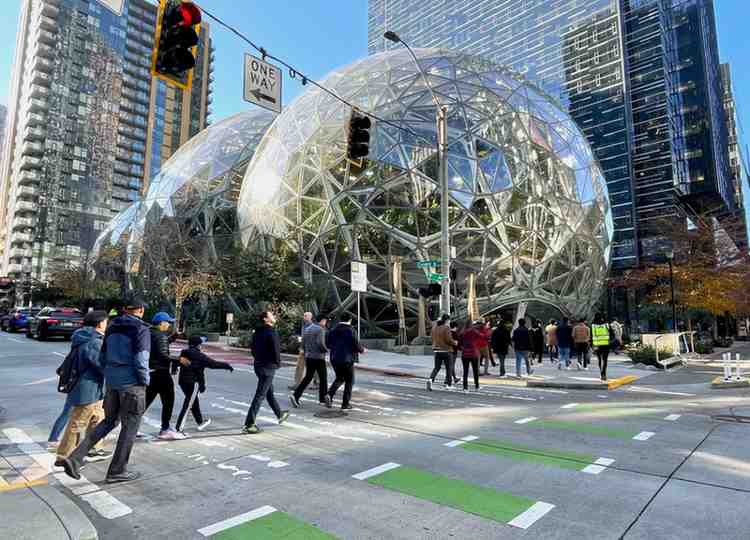
Starting January 2, 2025, Amazon will require employees to return to their offices five days a week, a significant change expected to influence Seattle’s downtown recovery and regional traffic dynamics. Amazon CEO Andy Jassy announced the policy, emphasizing that in-office work fosters collaboration, innovation, and stronger company culture. The move marks a return to pre-pandemic working conditions for approximately 350,000 Amazon employees globally, including 55,000 based in Seattle.
Downtown Seattle’s Post-Pandemic Recovery Boost
Amazon’s decision is viewed as a pivotal step for downtown Seattle’s post-pandemic recovery. As the city’s largest employer, Amazon’s workforce has a significant impact on the local economy. According to the Downtown Seattle Association (DSA), the return of Amazon workers is expected to revitalize businesses in neighborhoods like South Lake Union and the Denny Regrade area.
“Amazon’s return to five-day office work is a home run for downtown,” said DSA CEO Jon Scholes. He highlighted that increased foot traffic would boost the vibrancy and economic activity of the area, encouraging other employers to follow suit.
Traffic Congestion Expected to Rise
While the return to office is celebrated by local businesses, it’s anticipated to exacerbate Seattle’s traffic congestion. Past data from INRIX revealed a 35% drop in speeds on I-90 during Amazon’s initial return to a three-day workweek in 2023. Aisha Dayal from the Washington State Department of Transportation (WSDOT) advises commuters to plan ahead, utilize real-time traffic apps, and consider alternative routes to mitigate delays.
Ryan Avery, deputy director of the Washington State Transportation Center, noted that the shift coincides with Seattle’s “Revive I-5” project in spring 2025, which will reduce traffic capacity on key routes. Avery urged Amazon to consider offering flexible work options during this period to alleviate potential commuting challenges.
Local Businesses Poised for Growth
Seattle’s small businesses, particularly in food and retail, are optimistic about the increased foot traffic. Christopher McClendon, owner of Pararepas food truck, shared that pre-pandemic sales reached $2,500–$3,000 daily, a stark contrast to the $350 daily average during remote work. The five-day return policy is expected to restore these numbers, helping local businesses regain stability.
“We’re eager to see more Amazon employees back in the area,” McClendon said. “It’s not just about sales; it’s about the energy and connection they bring to the community.”
Employee Reactions to Full-Time Office Work
The new policy has drawn mixed reactions from Amazon employees. While some appreciate the structure and collaborative opportunities of in-office work, others have expressed frustration, citing disruptions to their personal routines. One employee described the return as “live-action role-playing and virtue signaling” on LinkedIn. However, new hires like Shreyas Pawar see potential benefits, noting improved productivity in Amazon’s well-equipped office spaces.
Amazon’s Vision for Culture and Collaboration
CEO Andy Jassy reinforced the importance of being physically present in the office to strengthen teamwork and drive innovation. He noted that remote work was never a default at Amazon prior to the pandemic and reiterated the company’s commitment to its customer-focused culture. Jassy acknowledged that the transition may require adjustments for some employees but stressed its necessity for long-term success.
Broader Implications for Seattle’s Economy and Infrastructure
As Amazon’s full-time office return begins, the ripple effects on Seattle’s economy, traffic, and public transit will become more apparent. Local businesses are gearing up for increased demand, while city planners and commuters brace for heavier traffic. The move underscores a broader trend of companies prioritizing in-person collaboration to enhance performance and culture.
Preparing for the Shift
WSDOT advises commuters to stay informed about traffic conditions through its app and website, offering real-time updates to help navigate the changes. Amazon is also supporting employees by providing public transportation incentives, rideshare options, and shuttle services to ease commuting challenges.
As Seattle adapts to this shift, the return of Amazon’s workforce is poised to redefine the city’s post-pandemic landscape, balancing opportunities for economic growth with challenges in urban mobility.
